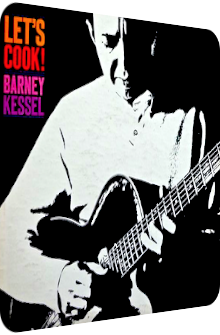
Barney Kessel
Let's Cook!
1957 / 1962
If AmbientExotica were to jump the shark with this review, it would be my pleasure to cook this particular brute (disclaimer: I do not endorse eating sharks, nor have I ever eaten a single piece of one). It is time to talk about the wonderful Let’s Cook! by guitarist extraordinaire Barney Kessel (1923–2004) who takes over the role as the chef de cuisine and serves a five-course meal with the help of a quintet and a septet of kitchen ancillaries. The first three menus are prepared on November 11, 1957, with the remaining two on side B being concocted a few months prior on August 6. The album, however, has only been dished up late in 1962 by Contemporary Records.
But enough of that gastronomic language for now, let’s talk music, or to be more precise, Exotica. What could possibly be exotic about an album such as Let’s Cook!, apart from the title's exclamation mark? If you check out the Exotica Review Archive, you can form an educated guess. It is a sad state of affairs, but the Exotica section of AmbientExotica may only span 60% real Exotica albums, and this number is decreasing for good reasons, with Barney Kessel’s Let’s Cook! being one of them, pushing me to halfheartedly mention ye olde disclaimer that Let’s Cook! is no Exotica album per se. However, please bear with me over the course of this review – and way beyond if you are actually willed check out this work – as it shares (one too) many characteristics to let it slide. Side A and B feature the talents of bandleader Barney Kessel, bassist Leroy Vinnegar and drummer Shelly Manne, whereas side A also features pianist Hampton Hawes and vibraphonist Victor Feldman, and side B replacing the vibraphonist with trombonist Frank Rosolino, saxophonist Ben Webster and substituting pianist Hampton Hawes with Jimmy Rowles. Actually rooted in the – back then – latest Bebop genre trend, the album is nonetheless dreamy, melodious and strongly insouciant.
Exotica listeners should not have an aversion regarding exclamation marks, or else they could not enjoy many a wonderful classic and adjacent Space-Age artifact, but there is of course one activity that makes people uncomfortable, and it is exactly this request that is posed by Barney Kessel: the eponymous opener Let’s Cook! replaces the much more affirmable and loved order let’s eat!, but still knows how to enchant. Right from the get-go, things look frilly, for this is a long-form piece of a whopping eleven minutes, its rhizomes and tendrils reaching to the Bebop genre as depicted by Leroy Vinnegar’s double bass billows, Hampton Hawes’ brightly-lit piano accompaniment and Victor Feldman’s city-strolling vibraphone droplets. Shelly Manne’s percussion, meanwhile, comprises of frizzing cymbals, business as usual.
Barney Kessel is not introduced until five minutes into the bopping luminescence where his laid-back yet skillful guitar twangs meander through the positively streamlined and purposely accessible flume. This corker may not be particularly exotic, true, but neither is it suitable as mere background music for a cooking show. Granted, a strong dose of arbitrariness and alatoric, freely flowing formations cannot be denied. However, the big boon of Kessel’s construction is the implication of moving forward, of visiting certain places and facing multiple situations, even if these are merely implying a busy cook’s inspection rounds. Let’s Cook! is harmless fun, and depending on the listener’s perspective, delightfully compatible with the Exotica genre, or by these very means way too boring to cope with the more adventurous classics. I for one am willed to place it somewhere in a snugly shelter between Space-Age and Exotica.
There is not much room left on side A to feature similarly proportioned monoliths, but what the following two songs lack in runtime, they deliver in coziness and wondrous mellifluousness. Time Remembered is one of Barney Kessel’s famous downtempo compositions akin to 1963's Twilight In Acapulco. It meanders along gently and utterly languorously, with the chef's champagne-colored guitar globs conflating with the silkened double bass backdrop, the dreamy vibraphone flecks and quiescent piano tones, the latter of which retain a certain jumpiness and punch, but otherwise float through the hammock-friendly atmosphere.
Time Remembered resembles both warm sunlight and mysterious moonlight at the same time, is undoubtedly exotic and utterly focused on the instrumentalist’s interdependence rather than the frequent solo portions that made up a majority of the Let’s Cook! tune. Time Remembered is a mellow mélange par excellence. Just In Time sits right in the interstice between Bebop and exotified material in that it features the archetypical double bass mountains and valleys as played by Leroy Vinnegar, and the fact that it is a mildly swinging piece overall. The interplay between the musicians lets it tower above the competition, for the enmeshment of the surfaces and instrumental patterns is undoubtedly miraculous, the flow is just right; Kessel’s mountainous guitar movements coalesce with Victor Feldman’s similarly saltatory vibe. Eclecticism is not what the band enforces. Euphony and silkiness are better words.
Side B sees a partially new band around Barney Kessel. The vibraphone is completely dropped and replaced by Frank Rosolino’s trombone and Ben Webster's saxophone; pianist Jimmy Rowles enters the kitchen as well. Since both brass instruments are perfectly embedded and do not tower above the arrangement, as outbursts and eruptions are completely amiss, the duo of compositions is still strongly compatible with a vintage Exotica lover’s needs. These are not necessarily evoked by the album title, so much is clear, but side B's opener Tiger Rag is undoubtedly very close to the jolly glorification of sunny lands: Kessel’s wonderfully thermal guitar strumming serves as the helical and positively somnolent base for sunlit piano chords, translucent bass waves as well as mild-mannered trumpet protrusions.
The mood is yet again totally harmless and unexciting, but this encapsulation process is up to the album’s endemics and intrinsic standards. Tiger Rag revisits the scheme of the title track by leaving enough room for each musician to unfold his specific talent and showcase his signature instrument. Upbeat and carefree, Tiger Rag is Jazz par excellence. The finale Jersey Bounce inherits dynamics and energy in its title, but in lieu of these prospects rather fathoms out the easygoing reliance of each band member. The polyphony of the trombonist and trumpeter makes for a particularly enthralling textural embroidery, as are their respective solo parts. Kessel’s backing guitars are beyond dreamy and much more efficient than the luminary’s solo melodies. The finale keeps the physiognomy, but focuses on pianist Jimmy Rowles’ expertise.
No news here, it has been mentioned in the first paragraph already: Let’s Cook! is no designated Exotica album – it probably would have been if its title were Let’s Cook Humans! – but euphony, catchiness, textures, its pool of instruments as well as the omnipresent ease of mind make this a feast for Jazz fans who favor insouciant concoctions over breakneck conquests and convoluted frenzy. It shares many a characteristic trait with the Exotica genre, even if it is just the most basic assertion in terms of its accessibility: like most wildly popular genre classics by the favorite quartet of one’s choice, Let’s Cook! is tremendously embraceable and absorbing. A highly skilled guitarist such as Mr. Kessel does not need to prove his prestidigitation on each and every release, and the result is henceforth all the more convincing. The rhythmic structures are stringently streamlined and maintained and are thus perfect backdrops or golden threads for the respective instrumentalists to unleash the power of their signature devices. There is another old adage I often use in my reviews, one which is also applicable here in a slightly different form: a vibraphone alone does not make an Exotica record. But vibraphonist Victor Feldman definitely ennobles the first three tracks, and strongly so, and so do Barney Kessel’s various guitar licks.
From the fuzzy warmth of his backing chords in the title track over the sleazy mirthfulness in Just In Time to the sunlit sinews in the uptempo Tiger Rag, Kessel is in the spotlight on the one hand, but then again, as he tends to do on many of his albums, remains under the radar in order to let his band mates shine on the other hand. If one demanded this humbleness of pianists Rene Paulo and Irving Fields, chances are that they would raise a brow… in Roger Moore style. The shift away from the guitar improves Let’s Cook! and lets it come closer to that archetypical Exotica sound. Bongos, congas and birdcalls are amiss, as they should in every kitchen, but mostly everything else is on the menu. Let’s Cook! is available on black plates, smaller silver platters and on the menu of digital-only restaurants.
Exotica Review 321: Barney Kessel – Let's Cook (1957). Originally published on Mar. 8, 2014 at AmbientExotica.com.
